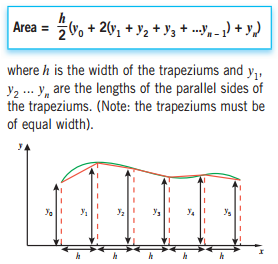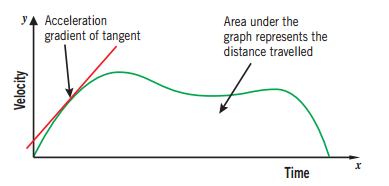 At commencement glance it appears that calculus features inwards the novel GCSE specification. On closer inspection it turns out that our students volition detect the slope of a plication past times drawing a suitable tangent rather than past times differentiating. And instead of integrating, students volition use the trapezium rule (or similar) to detect the expanse nether a curve. So calculus remains reserved for Key Stage 5, merely our students volition straightaway go amend prepared for calculus when they commencement regard it. GCSE volition create got given them a conceptual agreement of charge per unit of measurement of modify together with an powerfulness to translate this contextually.
At commencement glance it appears that calculus features inwards the novel GCSE specification. On closer inspection it turns out that our students volition detect the slope of a plication past times drawing a suitable tangent rather than past times differentiating. And instead of integrating, students volition use the trapezium rule (or similar) to detect the expanse nether a curve. So calculus remains reserved for Key Stage 5, merely our students volition straightaway go amend prepared for calculus when they commencement regard it. GCSE volition create got given them a conceptual agreement of charge per unit of measurement of modify together with an powerfulness to translate this contextually.This postal service talks you lot through this novel GCSE topic - it tells you lot what you lot demand to learn together with provides links to resources.
Specification together with Exam Questions
Here's the relevant extracts from the novel GCSE specification:
This all becomes clearer when nosotros await at example examination questions. Huge thank you lot to Tom Bennison (@DrBennison) for doing the difficult operate for me hither - he's been through the sample assessment materials for all examination boards together with collated the relevant questions inwards this Subject Knowledge Check. In a typical question, students are given a velocity-time graph together with asked to detect the amount distance travelled and/or the acceleration at a specific time.
AQA helpfully provides additional clarification nigh the specification inwards their instructor guide. The extract below is from GCSE Mathematics (8300) Teaching Guidance (available to All About Maths members) which provides a release of additional example questions.
The diagrams below are taken from this extract from a novel GCSE textbook which sets out the criterion methods that our students volition use.
Students volition already know how to detect the slope of a direct business (ie 'rise over run' or equivalent). To guess the slope of a plication they volition create got to pull a tangent, every bit shown here:
They'll also demand to create upward one's hear whether the slope is positive or negative.
To guess the expanse nether a graph, students volition create got to dissever the expanse into sections. The AQA Teaching Guidance says 'the trapezium dominion demand non go known merely it is recommended every bit the most efficient way of calculating the expanse nether a curve'. Unlike at Influenza A virus subtype H5N1 level, they won't go given the formula inwards the exam.
The option to using the trapezium dominion is to dissever the expanse into a release of triangles together with rectangles.
Motion Graphs
The methods described to a higher house are fairly straightforward. I recall interpretation powerfulness examine trickier (eg agreement what motion graphs are showing). Students volition demand to know that speed, acceleration together with deceleration are rates of change, together with that the expanse nether a velocity-time graph represents distance. There's a lot of novel concepts together with vocabulary here.
Bear inwards hear that motion graphs come upward up inwards Physics GCSE too. As shown inwards this extract from the AQA Physics GCSE Specification, it's precisely the same content:
Other Contexts
I was initially confused past times the cite of 'graphs inwards fiscal contexts' inwards this department of the specification - I've seen questions inwards which students create got to interpret fiscal graphs merely cypher involving tangents or areas. Thanks to @DJUdall for sharing the moving painting below (taken from this novel GCSE textbook) which shows an example of estimating a charge per unit of measurement of modify inwards a fiscal context.
Instantaneous Rate of Change
Students volition demand to empathise the divergence betwixt an average charge per unit of measurement of modify over a menstruum of fourth dimension together with an instantaneous charge per unit of measurement of change. In my postal service 'Introducing Differentiation' I talked nigh how to give students an intuitive agreement of the slope of a plication at a point. It's worth reading the department entitled 'An Instantaneous Rate of Change' for ideas, videos together with resources (including my worksheet 'Thinking About Gradient' which was designed for Influenza A virus subtype H5N1 degree merely is straightaway suitable for GCSE).
Resources
Resources for this topic are listed below. I'll add together these to my library together with volition go along to add together novel resources every bit I detect them.
Other Contexts
I was initially confused past times the cite of 'graphs inwards fiscal contexts' inwards this department of the specification - I've seen questions inwards which students create got to interpret fiscal graphs merely cypher involving tangents or areas. Thanks to @DJUdall for sharing the moving painting below (taken from this novel GCSE textbook) which shows an example of estimating a charge per unit of measurement of modify inwards a fiscal context.
Could examination questions encompass other contexts, also motion together with finance? It's possible. In the example below from CIMT students are asked to detect the majority of H2O represented past times the shaded area. To empathise why the expanse nether the graph represents majority nosotros tin dismiss consider the units - the units on the horizontal axis are seconds, together with the units on the vertical axis are m3/s, then when nosotros multiply the 2 together nosotros larn m3.
Students volition demand to empathise the divergence betwixt an average charge per unit of measurement of modify over a menstruum of fourth dimension together with an instantaneous charge per unit of measurement of change. In my postal service 'Introducing Differentiation' I talked nigh how to give students an intuitive agreement of the slope of a plication at a point. It's worth reading the department entitled 'An Instantaneous Rate of Change' for ideas, videos together with resources (including my worksheet 'Thinking About Gradient' which was designed for Influenza A virus subtype H5N1 degree merely is straightaway suitable for GCSE).
Resources
Resources for this topic are listed below. I'll add together these to my library together with volition go along to add together novel resources every bit I detect them.
- @DJUdall has produced this first-class graphing activity which covers both tangents together with areas nether graphs.
- @jase_wanner has written this super hero activity on distance-time together with speed-time graphs to prepare students' agreement of how to translate these graphs.
- Gradient on a curved graph by Owen134866 on TES gives students the chance to practice drawing graphs together with tangents. My worksheet Finding the slope of a plication using a tangent is similar, merely students aren't required to pull the graphs themselves.
- Using Graphs from CIMT covers a broad arrive at of graph topics. Section 17.2 covers areas nether graphs using the trapezium dominion together with Section 17.3 covers tangents to curves. The amount arrive at of resources for this module are available on TES.
- Nuffield Mathematics provides a Free-Standing Mathematics Activity 'Speed together with Distance' which is nigh finding the expanse nether a speed-distance graph. Resources include slides, a student sheet and teacher notes.
I promise this postal service has been useful inwards helping you lot fix to learn this novel GCSE topic. Please permit me know if you lot create got whatever resources to share.
You powerfulness also detect my other posts nigh novel GCSE topics helpful: Sequences, Inequalities together with Quadratic Graphs.
See my New GCSE Support Page for resources together with links for all novel GCSE content.
You powerfulness also detect my other posts nigh novel GCSE topics helpful: Sequences, Inequalities together with Quadratic Graphs.
See my New GCSE Support Page for resources together with links for all novel GCSE content.











